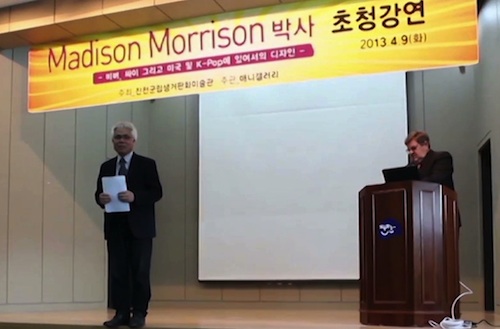

Justin Bieber, Baby and
PSY, Gangnam Style
Justin Bieber, Boyfriend and
PSY, Right Now
G-Dragon, Crayon and
Taylor Swift, Begin Again
Big Bang, Monster and
Nu’Est, Face
After Justin Bieber had begun to roach his hair, an Australian interviewer announced that he seemed to her an amalgam of James Dean and Elvis Presley. What she of course was leaving out was Michael Jackson, the one Pop Idol whom the Biebs acknowledges that he has yet to surpass. Unlike his persona, Bieber’s music amalgamates more: rock ‘n’ roll, disco, R&B, rap (he refers to his lyrics as “raps”), among other influences. He is, in short, a hybrid.
Likewise, Korean Popular Music, according to Kim Chang Nam (K-Pop: Roots and Blossomings, 2012), “is primarily characterized by hybridity.” He enumerates “trot, standard pop, pop ballad, folk, rock, soul, hip hop, R&B, electronic and dance music” (pp. 12-13). We will not concern ourselves much with its earlier development, picking up the story instead with South Korea’s more recent urbanization and its concomitant commercialization of mass culture.
The main channel of the inflow of American music in the 1950s into Korea was the Eighth US Army shows. From the late 1950s to the late 1960s, jazz, rock, and rhythm and blues were broadly absorbed into the field of Korean popular music through a variety of musicians who played songs on the Eighth US Army stages. Soul music first gained wide popularity as a distinctive genre in Korean popular music from the late 1960s to the early 1970s.
Nor will we dwell upon historical figures who precede the 1990s, when “the culture of the sinsedae, or new generation, took hold” and “mass-produced idol groups took over the popular mass market as a corporate management system was established.” Following the late 1990s the Era of K-Pop begins. After the Indie groups come H.O.T., Sechs Kies, Shinhua and G.O.D., plus the female S.E.S. and Fin.K.L, made up of Lee Hyori, Sung Yuri, Ock Joo-hyun and Lee Jin.
Following the mid-2000s emerged the Second Generation Idols, the so-called Hallyu boom. TVXQ appeared along with Super Junior (2005), Big Bang (2006), SHINee (2008), 2 PM (2008) and 2 AM (also 2008). The Wonder Girls made their debut (2007), followed by Girls’ Generation, Kara, 2NE1, Brown Eyed Girls, After School and 4MNUTE, their impact “sustained by emerging crews such as f(x), T-ara, Rainbow and Miss A.” Groups became larger, and sexier.
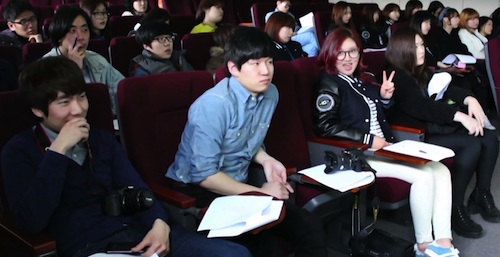
The day that I arrived in South Korea for my lecture, the Head of Engineering Design for Jaguar, being interviewed on TV, said, “Korean design is flamboyant.” The program was followed by an advertisement for “Collection and Concert” (Justin Bieber makes most of his money off his collection of tee-shirts; G-Dragon is a leader in Korean male fashion design). The Music Videos (and concerts) depend upon Costume Design, Dramatic Design, Musical Design and Lyric Design.
Among the elements in the last of these is the artful disposition of English titles, lines and phrases (for songs otherwise in Korean):
In Gangnam Style: “Hey, sexy lady.”
In Crayon: “Why so serious?” (The Joker’s line from Batman)
In Monster: “I’m not a monster.” “I think I’m sick.”
In Face: “Jackpot”

Simplicity in K- and A-Pop is a consciously economical design principle, e.g.:
Bieber, Baby, The moment of falling in love
In the video, “Behind the Scenes,” a montage of shots and scenes on the set of “Baby,” Bieber, acknowledging his source in a song of Michael Jackson’s, speaks of pursuing a girl. An actress, hired for but apparently not informed of the plot of the vid, at one point says to Bieber, “Why are you chasin’ me?” “Because you are so gorgeous,” he replies, “and have such a great personality.”
She turns away, overwhelmed with emotion. We have witnessed the actual moment during which she falls in love with Bieber, a moment captured for the final version of the video. Much the same happens in Gangnam Style, where, in the subway scene, both PSY and Hyuna are suddenly attracted to one another. Having fallen in love, they next appear dancing together on stage. PSY, though married and with children, is reported to have had an affair with Hyuna.
cp. PSY, Gangnam Style
(1) The moment of falling in love
(2) Horses: in Mongolia, China, Japan and Korea
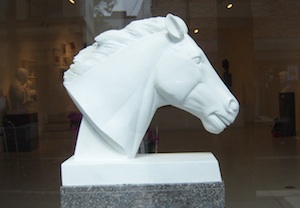
Wikipedia has a well-documented article on “Horses in East Asian warfare” (its footnotes and bibliography longer than its critical text) and more specialized articles on the horse as a vehicle for warfare and various equestrian forms of tactics and strategy, including individual prowess, in Burma, China, Japan, Korea and Inner Asia, where the horse’s universality may hold the key to the reception of Gangnam Style, with its themes of riding horses and being ridden like them.
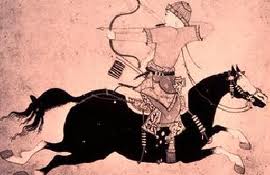
“Horses in East Asian warfare,” the first article begins, “are inextricably linked with the strategic and tactical evolution of armed conflict. A warrior on horseback or horse-drawn chariot changed the balance of power between civilizations.” “As in most cultures [cp. the Amerindian horseman, who preceded the American cowboy with his saddle] a war horse in East Asia was trained to be controlled with limited use of reins, responding primarily to the rider’s legs and weight.”
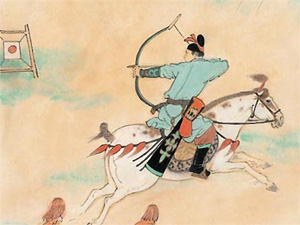
The horse as vehicle for warfare, then, is not only universal to East Asia but, with a modern history in America and an ancient history in Europe, more broadly so. “Chinese warhorses were culled from the vast herds roaming free on the grassy plains of northeastern China and the Mongolian plateau.” “The hardy Central Asian horses,” like PSY, “were short-legged with barrel chests.” Not only PSY’s stature but the stature of contemporary South Korea too may be apposite.
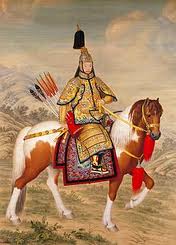
“The Korean horse is the smallest in East Asia, but it is noteworthy for its strength and stamina in relation to its size.” PSY is 5’ 7” tall. Wiki goes on to summarize the history of the horse in Korean warfare, the earliest example recorded during the ancient kingdom of Gojoseon. “The influence of northern nomadic peoples and Yemaek peoples on Korean warfare dates from the third century. By roughly the first century BC, Buyeo also had mounted warriors.”
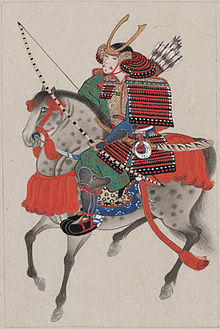
Subliminally, then, the Korean use of the horse to resist Japan, and its equality in horsemanship with China, may figure in the power that the image has for a Korean audience, however little they may reflect upon the matter. Horses figure in the MV’s second scene, and again in the coda, but are transferred to human figures throughout. Chinese had few horses and rode them badly. Koreans had many and, like Mongolians (another Altaic equestrian culture), rode them well.
cp. Bieber, Boyfriend
(1) Cars: vintage ’60s and ’70s American collectibles
(2) The moment of falling in love
Though the culture of the American Western film is dominated by horses and the horses are dominated by cowboys and Indians, the American culture of Bieber’s Boyfriend is automotive. Rich kids, that is, kids with rich parents, have managed to buy, in 2010, classic American cars from the era of the 1960s, 1970s and 1980s. Near the outset, for example, we see two girls in a vintage Corvette convertible, watching the video of Bieber in contemporary black-and-white.
The American romance of the car is, like East Asian warfare and horses, inextricable from Romance itself. Bieber’s video again shows the moment when the girl falls in love, having been courted by a crooner who says, “I wanna be your boyfriend.” (PSY and Hyuna’s attraction in Gangnam Style seems more spontaneous and mutual, perhaps befitting the animal rather than mechanical motif.) At any rate, cars have replaced horses, as American did earlier pop cultures.
All the cars that have been driven to a downtown urban space, otherwise perhaps unoccupied on the weekend, are contemporary collectibles, dating from the era of Elvis Presley and James Dean, transferred to the present. If PSY’s equestrian past is merely subliminal, the automotive past is drawn up into Bieber’s present. PSY’s action, in Gangnam Style, as it was in Right Now, is scenically dispersed, Bieber’s, concentrated, in Baby’s bowling alley and Boyfriend’s parking lot.
PSY, Right Now
(1) Innocence
(2) Cars (instead of horses)
The world of Right Now is decidedly innocent. All gives way to dancing: the traffic jam; office routine; supermarket shopping; waiting for a train. Skateboarding in the park is a harmless activity. Modern life, as in Charlie Chaplin, whom PSY here imitates, is comedic. Rules are broken: one may dance on the roof of someone else’s car; one may quit working. The cast reverts from middle aged to youthful, until PSY finally reprises the opening scene of the MV.


We will take up Innocence in G-Dragon, Swift and Nu’Est as we come to them. First a brief note on the fundamental generic difference between Bieber’s and PSY’s work. When one plays Gangnam Style or Right Now for people, they laugh. PSY is a satirist. When one plays Baby or Boyfriend for people, they are conflicted with opposing emotions. Like their eighteenth-century English model, sentimental drama, Bieber creates a world of good amidst urban evil.
cp. G-Dragon, Crayon Innocence
It is G-Dragon who is the Korean equivalent of Bieber, not PSY (though he has proposed collaborating with Bieber, he is not of the same temperament). G-Dragon is in between, an innocent but also a hard-edged satirist. (We recall that he is the author of most of Big Bang’s more complex songs.) One of a Kind, like Bieber’s work, is self-congratulatory rather than comic. His more recent work, as in Breathe, leads the way toward what is called “Ethereal Hip Hop.”
Crayon is exuberant, colorful (like crayons) and ritual in its choreography, but it is also philosophical, turning the new Joker’s line “Why so serious?” into a screed against authority: parents, school, philosophical probity. Paradoxically it reflects G-Dragon’s philosophical seriousness. At 24 he is five years older than Bieber, less accomplished overall than PSY, but a more impressive, impulsive master of dance than either rival and more volatile in his wit.
cp. Swift, Begin Again
(1) The moment of falling in love
(2) A past love
Taylor Swift is edgy too, but in a conventional way, like the country music that serves as her basis. At twelve she visited Nashville, at fourteen persuaded her parents to move there, so that she could imitate “Dolly [Parton] and Patsy [Kline].” The structure of her MVs, like the twang of her voice, is still Country. “He didn’t like me wearin’ high heels, but I did.” She is forever trying to return to a lost, or achieve a present, innocence, and she often succeeds, as in Twenty-two.
In Begin Again her Nashville becomes Paris. Bieber’s friend, she is innocent, but sentimentally. Her buoyancy derives from an inner strength, a self-confidence. By age 22 she had made US$165,000,000; she must be doing something right, and she has the fan base to prove it. Parisian innocence is her idea but also that of accomplished scenic directors and editors. The Seine, the Eiffel Tower, the Opéra; the Louvre, the Tuilleries, an old café. All is conceived in a haze.
Big Bang, Monster
(1) “Pop Evil”
(2) The proclamation of love
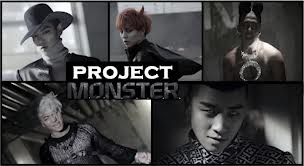
Big Bang began as a boy band (and still plays this routine); it evolved through a serious absorption of hip hop.The Monster in Me (the song’s original title) is egregious in their oeuvre. Each highly talented, differentiated solo star in the group’s membership must acknowledge his own monstrosity (“I think I’m sick,” says Daesong) and transform himself by a proclamation of love, figured in the destruction of and escape from a prison, where cars are violent but salvific.
Nu’Est, Face
(1) School experience
(2) Bullying
Again, unlike the rest of Nu’Est’s work, Face takes up a serious problem, school bullying, and solves it through collective action. This much younger group (four members are seventeen, one, nineteen) began as dancers for another group. Despite their ethereal daffiness in Not Over You, they are highly accomplished singers and actors as well as dancers. Like Swift’s Begin Again, the later song, Face, is about (1) a present innocence and (2) a past love. Face rivals Monster.
I have not included a K-Pop woman soloist (such as Hyuna), nor any of the highly influential women’s groups, such as Girls’ Generation. If anything, they are more accomplished than the men’s groups, though their success lies in a supreme skill at denying individual identities. Mr. Taxi might stand for this veneer. Its line, “Mr. Taxi, taxi, I’m so fast” suggests having sex (contrast innocence) in a taxi cab, another line, “London, New York, Tokyo, Seoul,” a universality.
